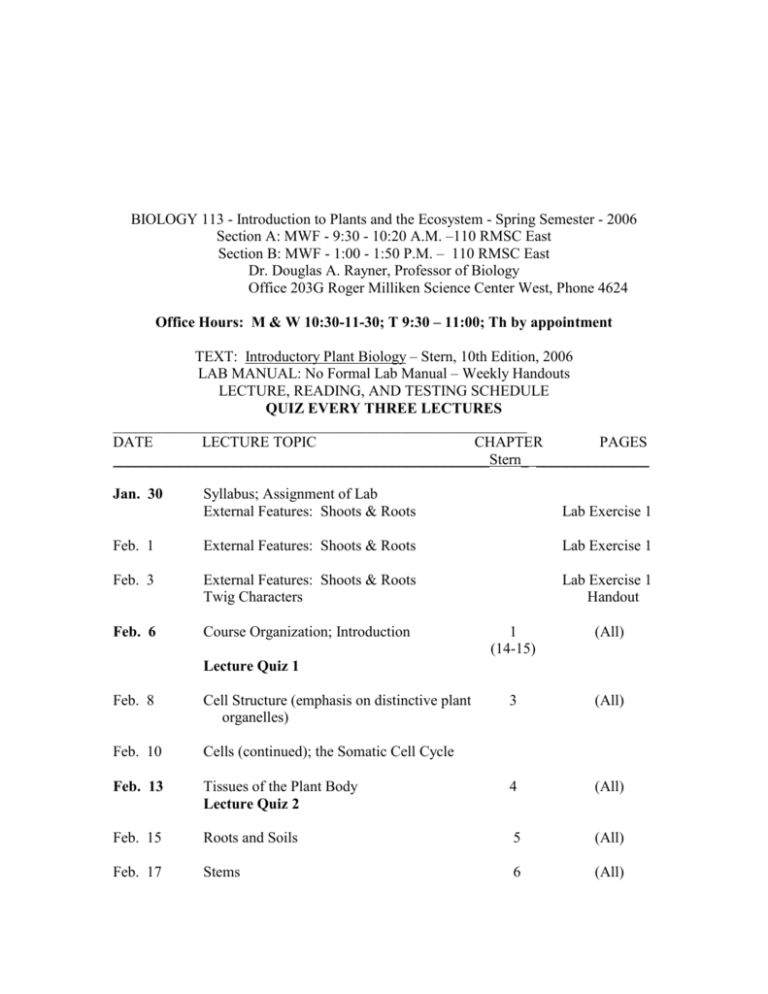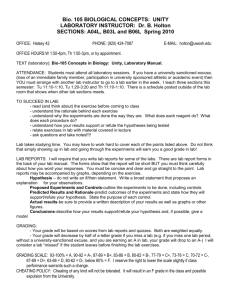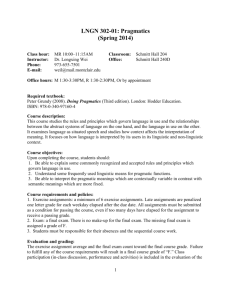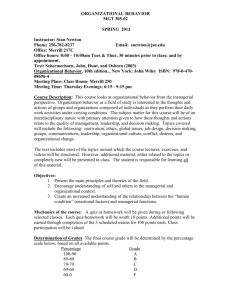BIOLOGY 113 - Introduction to Plants and the Ecosystem
advertisement

BIOLOGY 113 - Introduction to Plants and the Ecosystem - Spring Semester - 2006 Section A: MWF - 9:30 - 10:20 A.M. –110 RMSC East Section B: MWF - 1:00 - 1:50 P.M. – 110 RMSC East Dr. Douglas A. Rayner, Professor of Biology Office 203G Roger Milliken Science Center West, Phone 4624 Office Hours: M & W 10:30-11-30; T 9:30 – 11:00; Th by appointment TEXT: Introductory Plant Biology – Stern, 10th Edition, 2006 LAB MANUAL: No Formal Lab Manual – Weekly Handouts LECTURE, READING, AND TESTING SCHEDULE QUIZ EVERY THREE LECTURES _______________________________________________________ DATE LECTURE TOPIC CHAPTER PAGES __________________________________________________Stern_ _______________ Jan. 30 Syllabus; Assignment of Lab External Features: Shoots & Roots Lab Exercise 1 Feb. 1 External Features: Shoots & Roots Lab Exercise 1 Feb. 3 External Features: Shoots & Roots Twig Characters Lab Exercise 1 Handout Feb. 6 Course Organization; Introduction 1 (14-15) (All) 3 (All) Lecture Quiz 1 Feb. 8 Cell Structure (emphasis on distinctive plant organelles) Feb. 10 Cells (continued); the Somatic Cell Cycle Feb. 13 Tissues of the Plant Body Lecture Quiz 2 4 (All) Feb. 15 Roots and Soils 5 (All) Feb. 17 Stems 6 (All) Feb. 20 Leaves Lecture Quiz 3 Feb. 22 Leaves (continued) Flowers and Fruits 7 8 (All) (127-143) Feb. 24 No Class; Nature Conservancy board meeting, Columbia, SC Feb. 27 Review for Exam; Cones Mar. 1 Exam 1 (Does not include material on flowers, fruits, or cones.) Mar. 3 Seeds, Seed Germination, Seed Dormancy Mar. 6 Review of Exam 1 Plants and Energy Basics of C3 photosynthesis Lecture Quiz 4 22 (412-413) 8 (143-147) 10 (167-177) Mar. 8 Photorespiration; C4 and CAM photosynthesis 10 (178-180) Mar. 10 Membrane Structure and Function Diffusion, Osmosis and Active Transport 3 9 (36-37) (150-154) Mar. 13 Movement of Water and Solutes in the Xylem Lecture Quiz 5 9 (155-158) Mar. 15 Movement of Solutes in the Phloem Plant Nutrition 9 9 (158-160) (160-163) Mar. 17 Plant Breeding and Propagation 14 (All) Mar. 20 Review for Exam 2 Plant Hormones: Regulation of Growth and Development 11 (192-201) Mar. 22 Exam 2 (Does not include Mar. 20 lecture.) Mar. 24 Response of Plants to Environmental Stimuli 11 (201-214) Mar. 27 Review of Exam 2 Plant Names and Classification 16 (All) Mar. 29 Meiosis and Alt. of Generations; Life Cycles 12 Mar. 31 No Class: Association of Southeastern Biologists meeting in Knoxville Apr. 4-7 SPRING BREAK April 10 22 Apr. 12 Seed Plants: Gymnosperms Lecture Quiz 6 Seed Plants: Angiosperms 23 (All) Apr. 14 Flowering Plants and Civilization 24 (All) April 17 Edible, Poisonous and Medicinal Plants Lecture Quiz 7 Apr. 19 Review for Exam 3 Evolution 12 (412-428) (All) Apr. 21 LECTURE EXAM 3 (Does not include May 2 lecture.) Apr. 24 Evolution (continued) Review of Exam 3 Apr. 26 Ecology Apr. 28 Ecology (continued) Review of Lecture Exam 3 May 1 Ecology (continued) Lecture Quiz 8 May 3 Practical Ecology: Dr. Rayner’s Research on Deer and Invasive Species May 5 Review for Final Exam May 10 May 12 Section A (9:30-10:30) - FINAL EXAM 2:00 - 5:00 Section B (1:00-1:50) - FINAL EXAM 9:00 - 12:00 32 (All) COURSE GOALS - To obtain a detailed understanding of the structure and function of vascular plants, with an emphasis on flowering plants. - To obtain knowledge about, understanding of, and appreciation for plants and the vital role they play in everyday life and in functional ecosystems. - To obtain an understanding of basic ecological and evolutionary principles and the role of professional ecologists in assessing and understanding complex environmental problems. - To gain an appreciation for the complexity of ecosystems and the need for basing environmental policy on ecological principles, as interpreted by practicing scientists. - To learn to think critically, to distinguish fact from theory, and to distinguish personal opinion from scientific fact. WEEK Feb. 6-9 Feb. 13-16 Biology 113 - Laboratory Schedule Spring 2006 TOPIC EXERCISE External Features of Seed Plants Assessment: Lab Review Questions 1 Twig Characters of Common Campus Trees/Shrubs 2 Assessment: Producing a Twig Key to Common Campus Trees/Shrubs Feb. 20-23 Cell Structure & Cell Types Assessment: Lab Review Questions 3 Feb. 27-Mar2 Structure of Leaves Assignment: Ecological Modification of Leaves 4 Mar. 6-9 Cones, Flowers & Fruits Assessment: Lab Quiz 5 Mar. 13-16 Photosynthesis Lab Review Questions 6 Mar. 20-23 Field Trip to Carter and Holmes Greenhouses, Newberry Assessment: Lab Review Questions Mar. 27-30 Absorption, Conduction, and Transpiration of Water Assessment: Lab Review Questions 7 Mar. 28-31 Internal Regulators of Plant Growth External Factors and Plant Growth Assessment: Lab Review Questions 8 Apr. 3-7 SPRING BREAK Apr. 10-13 Field Trip: Plant Adaptations Assessment: Lab Quiz 9 Apr. 17-20 Evolution/Genetics (To be arranged) 10 Apr. 24-27 Ecology: Mimicry Assessment: Lab Report 11 May 1-4 Field Trip: Deer Exclosure at Croft State Park Invasive Species Project at the Cottonwood Trail CLASS OPERATING PROCEDURES I. ATTENDANCE 1. You are expected to attend and participate in every class meeting and every lab exercise. You will have an assigned seat and attendance will be taken. Your final average will be lowered one point for each unexcused absence in excess of one (1). Students with no unexcused absences (0) for the entire semester will have 1.5 points added to their final average. If you enter the classroom after the lecture has begun, your tardiness will count as 1/2 of an unexcused absence. Students who have just one unexcused tardiness are still eligible to have 1.5 points added to their final average. If you have a valid excuse for your tardiness, please give me a note as to why you should be excused. 2. No make-up tests will be given except in the case of CLEAR CAUSE (i.e. very unusual circumstances which lead to clearly unavoidable absence). Arrangements for make-up tests must be made in advance. Labs missed for CLEAR CAUSE can only be made-up later in the same week. 3. If you are to be given extra time on exam for medical reasons, you must make arrangements with me in advance. II. GRADING SYSTEM This course is not graded on a curve. It is graded based on standards that I have defined. EVERYONE HAS THE OPPORTUNITY TO EARN AN A! This course is graded on a typical 100 points (percent) grading system. Components of your grade are as follows: LECTURE Lecture Quizzes Lecture Exam 1 Lecture Exam 2 Lecture Exam 3 Final Exam Total - 15 percent 11 percent 13 percent 15 percent 16 percent 70 percent The Final Exam consists of: Ecology/Evolution = 6 percent; Cumulative Multiple Choice (CMC) = 10 percent. If the grade on your Cumulative Multiple Choice is higher than one of your exam grades, you may count the CMC grade 10 percent more and the lower exam grade 10 percent less. Each exam will be composed of both multiple choice and short answer questions. Exams will emphasize material covered in class, but material covered in assigned readings, even if not covered in lecture or class discussions, may be included on exams. LAB Lab Review Questions/Lab Quizzes Lab reports/ 30 percent Total 30 percent SUMMARY OF GRADING LECTURE 70 percent LAB 30 percent Your grade will be determined by the total percentage you accrue according to the following scale: 90 - 100.0 80 - 89.9 70 - 79.9 60 - 69.9 less than 60 = = = = = A B C D F Plusses and minuses will be awarded at appropriate point intervals for A, B, and C grades, e.g., 80-83.3 = B-, 83.4-86.6 = B. Your participation in class and lab will be noted, as will your general attitude. If your final average is on the borderline between a B and a B+, for example, your grade in class/lab participation will be used to determine whether or not you are bumped up to the higher grade.







